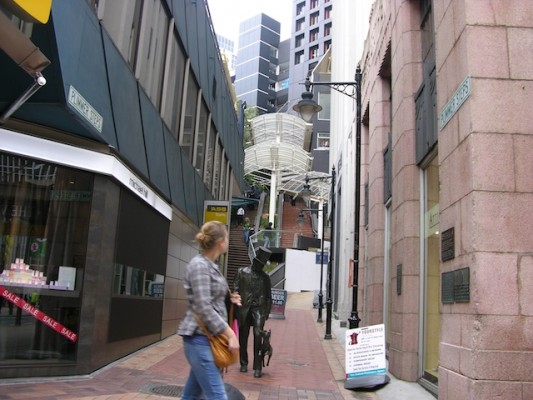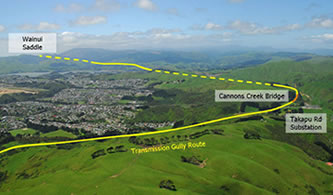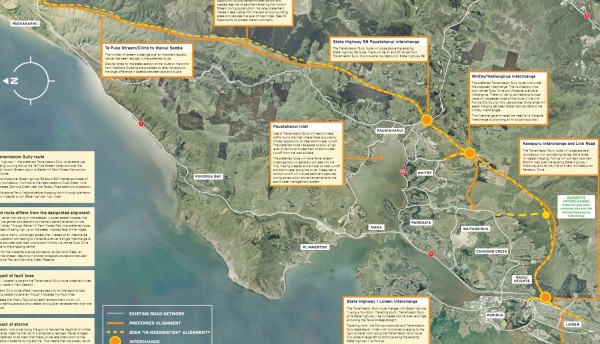Wellington Re-Thinks Transport
First Auckland, now Wellington is “re-examining” its transport wish list following the Christchurch quake and the Government’s warning they’re not in the mood for big projects beyond the Christchurch re-build.
Transmission Gully, the much-talked about 27km link between McKays Crossing and Linden, bypassing choke-points at Paremata and Pukerua Bay, is one of six road projects that make up the Wellington airport-to-Levin road of national significance, estimated to cost $2.4b.
It’s been heavily embraced by the Transport Minister and there have been those in Wellington campaigning for it for literally decades. In fact the announcement in 2009, came more than 60 years after the route was first proposed.
But it has had its local critics especially those in areas affected. The Greens Party has long opposed it with Gareth Hughes saying the Transmission Gully motorway has “no business case and will likely increase congestion in Wellington,” adding that the “best way to reduce congestion is not to build more roads but to have fewer cars on existing roads.”
And there have been environmental concerns, especially with worries of the impact on the ecology of local streams and the Pautahunui Inlet and the work leading to further sedimentation of the Inlet and Porirua Harbour.
In Wellington this week, the battle is on to save the project - or get it dumped.
The Porirua Mayor has written to Steven Joyce calling for the “economically critical” billion-dollar motorway project to be ring-fenced and saying if something has to go it should be the planned Petone-to-Granada link road, expected to cost $250 million and aimed at easing pressure on Ngauranga Gorge.
“The Petone-Grenada link is neither as urgent nor as economically critical as Transmission Gully. The link from SH1 to the Hutt Valley can be adequately covered on the current SH58 at Haywards, which could be enhanced at a much lower cost. The deferral or cancellation of this project would be a far preferable target for cost-cutting as the Government seeks ways to divert funds to Christchurch.”
The Wellington Chamber of Commerce is saying the project must not be halted arguing that local government politicians in Wellington shouldn’t be using the earthquake as an excuse to rethink Wellington’s transport priorities.
It says government expenditure which is able to boost economic growth in the country as a whole -and it classifies Transmission Gully as such - should not be sacrificed in the process of rebuilding Christchurch and it argues there must are better examples of “low-quality government expenditure” which should be cut so that funds can be diverted to Christchurch (without naming any such projects).
One point it makes is that the Christchurch earthquake also underlines the importance of Transmission Gully to Wellington because it shows how important access to and from the city would be after a natural disaster. How one gets north from Wellington after the city crashes in its own big quake is a common debate among those living there.
It’s a point also made by the Porirua mayor in favour of Transmission. ”Part of the route is a particularly important gateway to Wellington, Hutt Valley and Porirua and would be crucial in the event of a major disaster and key to improved access during a recovery.”
But even that is up for debate.
A DomPost story in 2009 said it had sighted Transport Ministry documents showing it could take longer to reopen after an earthquake than the coastal route, and that ministry officials told Mr Joyce this year that the economic benefits were low. It said the Gully was also not a panacea to the region’s roading woes. It would shave only 10 minutes off a peak-time trip from Kapiti Coast to Wellington, and would add to congestion in the capital.
NZTA estimates that Transmission Gully itself is expected to carry 18,300–22,300 vehicles/day by 2026. It says the existing SH1 route between Linden and MacKays Crossing will experience significant reductions in traffic volumes, ranging from 86% south of Paekakariki to 24% south of the Mungavin Interchange at Porirua.
Wellington’s new Mayor Celia Wade-Brown says the quake was a good chance to rethink transport priorities in the face of rising petrol costs and the main focus had to be on assisting the southern city.
The Ministers are hinting the quake will see major projects stall but are not making any announcements yet.
Finance Minister Bill English said major infrastructure projects would be delayed or diverted as the Government looks at find ways to fund the expected $16b Christchurch bill.
Mr Joyce said changing the timing of planned projects was possible but it was too early to say which ones, if any, would be affected.
We may have to wait until the May 20 budget.
Bill English continues to “prepare the nation” for bad news.
He said yesterday that Government financial statements for the seven months to January 31 are broadly in line with forecast, but this will change significantly in the coming months as the impact of the Christchurch earthquake becomes clear.
While the latest accounts show spending and revenue consistent with forecasts in the Half-Year Update in December, tax revenue was still about 4 per cent behind Budget 2010 forecasts.
“This result reflects the relatively flat economy in the latter part of 2010 and reinforces the need for sound fiscal management as we tackle the effects of the Christchurch earthquake in the coming months. As I’ve previously said, the earthquake will have a significant impact on the Government’s finances and the wider New Zealand economy for years to come. The Government will pay for the rebuilding of Christchurch by borrowing more in the short term, but also by prioritising spending on Canterbury over some other Government spending.
“It’s important we stick to our broader economic programme to reduce New Zealand’s vulnerability to foreign lenders, get the Government’s finances in order and build faster growth based on higher national savings and exports. “We need to ensure we have the resources to rebuild Christchurch and support its residents. The best way to pay for that is through sound management of our finances and building a faster growing economy.”
Transmission Gully was the second of three phases of work involving projects developed from Levin south.
Phase one was improving the highway from Ngauranga Gorge to Aotea Quay and the Basin Reserve, as well as work on the Peka Peka to Otaki section and the McKays Crossing to Peka Peka section.
Phase three would involve the duplication of the Mt Victoria and Terrace tunnels and work between Otaki and Levin.
In the Gully project, there will be interchanges connecting the route to State Highway 58 and to Kenepuru with a connection to Kenepuru Drive. In addition, there will be two link roads from the eastern Porirua suburbs of Whitby and Waitangirua to the route. The Porirua City Council will be the authority responsible for the Whitby and Waitangirua link roads.
At least the Government can not be accused of just using the quake to kill of only planned rail projects, like Auckland’s CBD link.
But as the dust has cleared from the quake zone and the focus turned to re-housing Christchurch people and rebuilding, we do need to keep a clear head about the fact Auckland and Wellington need to progress, not go backwards especially with the already fragile economy taking a hit.
The reality is that the CBD rail loop will both solve the fast approaching problem of Britomart reaching capacity -and revitalising the CBD.
Those arguments are in no way changed and there was strong local body endorsement of the CBD link business case.
Likewise, Wellington has been waiting for 60 years for Transmission Gully. And as with the CBD link, the government won’t fund it all. Tolling has always been mentioned as being needed for the Gully project or even a private public partnership, possibly with the Chinese.
Debates about both projects’ long anticipated future must be made with more beyond the emotional debate understandably taking place in the wake of the Christchurch tragedy for which all of New Zealand grieves.
More than ever, other parts of NZ must continue to prosper and develop;.















7 Comments
The level of thinking of disaster planning in Welly is this: In the event of a Wellington earthquake everyone is to immediately drive over the new Transmission Gully motorway and have an ice-cream in Bulls.
In the comments on the story in the Dom Post yesterday about the low, low BCR of the project, like 0.6, and someone else arguing that for big projects low BCRs don’t matter, because economic realities are just for little projects.
Why is it that people lose their wits, if they ever had them in the first place, for large motorway projects?
And petrol has just gone up to $2.19 a litre so the BCR would be even lower than 0.6, so according to some it’d make even more sense now.
Funding any project with a BCR of less than 1 is criminally wasteful at the best of times.
Funding highways with business cases that depend on international oil prices being at $25 per barrel long-term is just silly. Treasury should be ashamed for not challenging that.
When you’re trying to save money, the difference between another highway and a core public transport asset like the (BCR 3.5) Auckland CBD rail loop is night and day. Sorry, Wellington, but your business case just does not stack up.
I agree with the above comments, but is there a PT alternative? I don’t think there is, so either way you are going to have to throw money away on a motorway in some form, regardless of BCR.
That’s assuming an alternative motorway is required. of course…..
KLK, the Main Trunk Line runs right through Levin and Paraparaumu. There are train services from the north-west and north-east upper reaches of the Wellington region (and right up into the lower Manawatu) that go directly into Wellington CBD. If there’s no PT alternative to Transmission Gully then there’s no PT alternative to any road in New Zealand.
Enhancing park’n'ride facilities and train services from Paraparaumu would certainly help, but TG is not the only feasible option for dealing with the KCH/Nauranga Gorge leg. It’s also much cheaper to improve options for utilising existing rail links than to build a new motorway, and the BCR is pretty much certain to be positive.
The comment about rebuliding of Transmission Gully following an earthquake is entirely dependent on which fault an earthquake occurs on. If it happens on the fault that Transmission Gully crosses (which is an active fault with measurable movement every year) then an expected displacement of 5m to 7m will occur - this can’t be engineered out and will lead to a critical failure of a linear piece of infrastructure. If a quake occurs on a different fault (and there are several other active ones in Wellington) then the road could be engineered such that it is still at least partially serviceable.
KLK - There definitely is a PT alternative. Currently there are 3 train services, plus the seemingly redundant Kapiti Express bus. The Kapiti Line only goes as far as Waikanae. It is mainly a half hourly service. There are stations at Waikanae, Paraparaumu, Paekakariki and 2 at Pukerua Bay. The Capital Connection is only 1 a day and serves Palmy, Shannon, Levin and Otaki and then replicates the Kapiti Line further south. Then there is the Overlander which could be marketed as the reverse of the Capital Connection in the evenings (ie travels from Palmy to Wellington in the evenings) but the pricing of the Overlander is ridiculous (it costs $54 one way).
Improvements could be made to the existing SH1 such as: the Whitford Brown Ave overpass could be brought forward - and an Aotea station built.
A Pukerua Bay Bypass could be built, and Muri station closed (with new footpaths to walk from the Muri end of the town to the other station)
New stations could be built at Raumati and Lindale, including Park and Rides. (Waikanae’s Park and Ride is already at capacity 2 weeks after launch)
I’d run the Kapiti Line as two lines - a Porirua Line all stops Welly to Plimmerton, and a Kapiti Line of Welly, (a rebuilt) Kaiwharawhara, Porirua, and all stops Plimmerton to Waikanae. Increasing service on both to 3 or 4 tph.
The Capital Connection should be run as a 6 per day service between Waikanae and Palmie (I’d run it to Feilding too giving an intra-Manawatu service). And build the PalmyLink gondola and extend it from the Square to the train station and to Palmy airport.
Of course there is still the problem that the trains stop in Wellington Station and there is no rail option further south, but that is a different problem.
As for an immediate thing to do, would be to price the existing Overlander service between Palmie and Welly at the same prices as the Capital Connection and promote that, maybe with an extra couple of carriages.
IMHO Transmission Gully would just be such a huge waste of resources and would need a hell of a lot of people to collectively lose a lot of marbles.
You know, as an ex-Palmy boy, I had completely forgotten about the train line (I used it about 4 times in 20yrs).
Sadly, I think the capital Connection to Palmy is under threat. But it is a good service. Like the idea of the Feilding-PN extension too Matt.